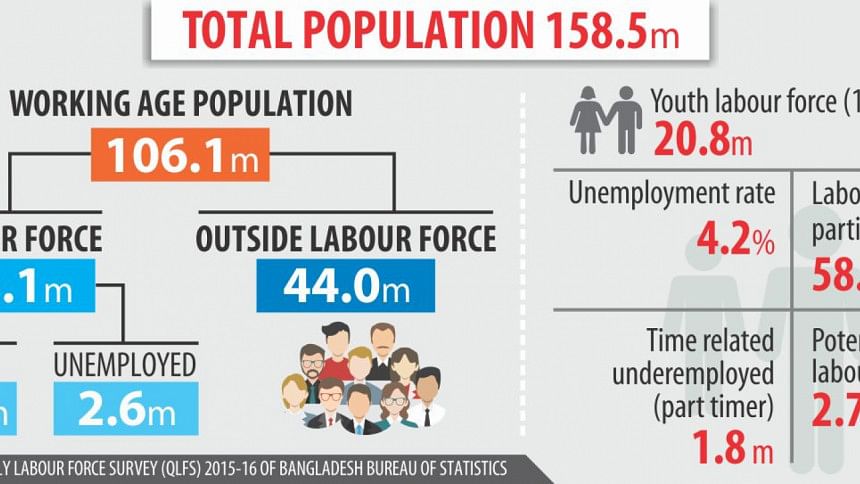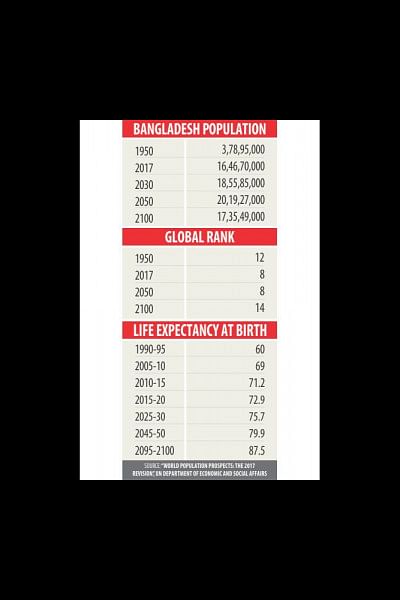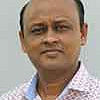Demographic Dividend: Big opportunity passing by

Bangladesh since 2007 has had more people of working age than non-working, known as demographic dividend, and by 2040 this window of opportunity to accelerate economic growth would start to close.
Now, more than 65 percent of the population are of working age, between 15 and 64.
Yet, Bangladesh is unable to exploit the full potential of the demographic dividend as it cannot create adequate number of jobs for the working-age population, according to economists and population scientists.
They suggested taking up measures including large-scale investments in education and health sectors to cash in on the demographic dividend.
Some of the East and South-East Asian countries have invested heavily in human resource development, in particular education and health, to achieve a higher economic growth rate during their time of demographic dividend when most citizens work, they said.
According to the experts, the size of working-age population of Bangladesh would start to decline and the country may not get this dividend again in future.
China, Japan and many other countries have reaped the demographic dividend to develop their economies but in Bangladesh, things are not on right track.
Bangladesh's economy has been doing well for the last several years but currently its job growth is the slowest in two decades.
With about 7 million people underutilised, Bangladesh observes the World Population Day 2017 today with the theme “Family Planning: Empowering People, Developing Nations”.
The country could add only 1.4 million jobs between 2013 and 2015-16 fiscal year, down from 4 million jobs it had added between 2010 and 2013, according to the latest data of Bangladesh Bureau of Statistics' Labour Force Survey.
The sluggish job creation has raised questions about the high economic growth figures being recorded, with some economists terming the phenomenon “jobless growth”.

Economist Hossain Zillur Rahman referring to data of the labour force survey said, "We did not capitalise on the demographic dividend … Youth frustration has been increasing as they are either not getting any job or expected jobs. Job opportunities have decreased."
He identified the reasons for not taking advantage of the demographic dividend, including a faulty education system, increasing unemployment, and a huge underemployment rate.
Zillur, executive chairman of the Power and Participation Research Centre, said the mid-level job market was gradually being occupied by foreign manpower in some sectors, which is a reason for worry.
“We have become complacent with the demographic dividend and are failing to cash in.”
He said there was a misconception regarding demographic dividend; people think Bangladesh has got the dividend and it would have it forever.
"A few people know that transforming the demographic dividend into economic dividend comes with a time frame … sense of urgency is needed. But unfortunately we do not have that urgency," he added.
Echoing Zillur, population scientist AKM Nurun Nabi said the demographic dividend usually continues for 30 to 35 years. The dividend usually comes once for a country.
"Now, we have more producers than consumers … We got the window of demographic dividend but we have to transform it into economic dividend," he told The Daily Star.
He said the government has set a target to become a higher income country by 2041. “It will be possible only if we properly utilise the manpower.”
Nabi said if the birth rate continued to drop as it has been, then the dividend might expire sooner due to decreasing labour supply.
"We are already late for formulating a proper plan to utilise the manpower even though the government has taken some initiatives.”
He said the government should have multi-sectoral focus, with special attention to education and health. Education should be skill and market oriented, not certificate oriented.
The government policymakers often speak of implementing various initiatives to transform the population into human resource but the situation has not improved much.
The latest progress report on UN Sustainable Development Goals or SDGs shows poor state of human development.
Out of 157 countries, Bangladesh ranked 120 in the SDG Index & Dashboards Report 2017 of the UN Sustainable Development Solutions Network.
The report marked 10 of 17 development goals of Bangladesh in red, indicating that the country needs to overcome major challenges to meet the goals, according to the report.
The red marked goals are: zero hunger; good health and well-being; quality education; affordable and clean energy; decent work and economic growth; industry, innovation and infrastructure; sustainable cities and communities; life below water; peace, justice and strong institutions; and partnership for the goals.
Bangladesh country has emerged as a major exporter of skilled, semi-skilled and unskilled labour but most of the export to more than 22 countries is unskilled labour.
Aminul Haque, chairman of Department of Population Sciences, University of Dhaka, said, “We still have time to capitalise on the demographic dividend.”
He said private sector and personal initiatives were expanding and that it could be done “if we can plan well in the next few years”.
Aminul said a coordinated and well thought-out plan was required in four sectors -- quality manpower export, expansion of private sector, and expansion of government sector and opportunity creation for the self entrepreneurship -- to get maximum dividends.


 For all latest news, follow The Daily Star's Google News channel.
For all latest news, follow The Daily Star's Google News channel. 



Comments